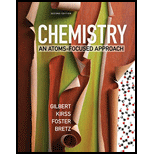
To find:
a) Write a balanced chemical equation based on the reaction (i).
(i)
(ii)
b) Combine equations (i) and (ii) to show the overall reaction in the titration.
c) Find the concentration of ascorbic acid in
Answer to Problem 8.124QA
Solution:
a) The balanced equation based on the reaction described in (i) is
b) The overall reaction in the titration by combining equations (i) and (ii) is
c) Concentration of ascorbic acid in lemon juice is
Explanation of Solution
1) Concept:
To balance a
2) Formula:
i)
ii)
iii)
3) Given:
i) Volume of lemon juice =
ii) Total volume =
iii) Concentration of
iv) Volume of
4) Calculation:
a) To write the balanced equation based on the reaction described in (i):
Assign oxidation number to
In
The oxidation number for
So, to balance the charge, we need to add a coefficient
Here
The
We need to balance the
All atoms as well as the charge is balanced for the above reaction. So, this is a balanced equation.
b) To write the overall reaction equation by combining equations (i) and (ii):
Combining equations (i) and (ii) to show the overall reaction in the titration:
i.
ii.
We have balanced equation (i) in part (a).
iii.
We need to balance equation (ii) in order to combine them:
To match the
iv.
Now add equation (iii) and (iv). We get
So, the overall reaction in the titration is
c) Finding concentration of ascorbic acid in lemon juice:
From the given molarity and volume of
Calculate the moles of
From the above reaction,
Convert the moles to grams and then to milligrams as
Calculate the concentration in
Concentration of ascorbic acid in lemon juice is
Conclusion:
Redox reactions are balanced by calculating
The stoichiometry in the balanced equation is used to find the concentration of the analyte.
Want to see more full solutions like this?
Chapter 8 Solutions
Chemistry: An Atoms-Focused Approach (Second Edition)
 ChemistryChemistryISBN:9781305957404Author:Steven S. Zumdahl, Susan A. Zumdahl, Donald J. DeCostePublisher:Cengage Learning
ChemistryChemistryISBN:9781305957404Author:Steven S. Zumdahl, Susan A. Zumdahl, Donald J. DeCostePublisher:Cengage Learning ChemistryChemistryISBN:9781259911156Author:Raymond Chang Dr., Jason Overby ProfessorPublisher:McGraw-Hill Education
ChemistryChemistryISBN:9781259911156Author:Raymond Chang Dr., Jason Overby ProfessorPublisher:McGraw-Hill Education Principles of Instrumental AnalysisChemistryISBN:9781305577213Author:Douglas A. Skoog, F. James Holler, Stanley R. CrouchPublisher:Cengage Learning
Principles of Instrumental AnalysisChemistryISBN:9781305577213Author:Douglas A. Skoog, F. James Holler, Stanley R. CrouchPublisher:Cengage Learning Organic ChemistryChemistryISBN:9780078021558Author:Janice Gorzynski Smith Dr.Publisher:McGraw-Hill Education
Organic ChemistryChemistryISBN:9780078021558Author:Janice Gorzynski Smith Dr.Publisher:McGraw-Hill Education Chemistry: Principles and ReactionsChemistryISBN:9781305079373Author:William L. Masterton, Cecile N. HurleyPublisher:Cengage Learning
Chemistry: Principles and ReactionsChemistryISBN:9781305079373Author:William L. Masterton, Cecile N. HurleyPublisher:Cengage Learning Elementary Principles of Chemical Processes, Bind...ChemistryISBN:9781118431221Author:Richard M. Felder, Ronald W. Rousseau, Lisa G. BullardPublisher:WILEY
Elementary Principles of Chemical Processes, Bind...ChemistryISBN:9781118431221Author:Richard M. Felder, Ronald W. Rousseau, Lisa G. BullardPublisher:WILEY





